|
February 1964 Popular Electronics
 Table of Contents Table of Contents
Wax nostalgic about and learn from the history of early electronics. See articles
from
Popular Electronics,
published October 1954 - April 1985. All copyrights are hereby acknowledged.
|
This Popular Electronics
article by at-the-time editor Oliver Ferrell offers recommendations on how to spot
a good deal in grab-bag assortments of electronics components when shopping for
good deals, whether it be at a retail outlet, flea market, or Hamfest. The advice
is a useful today as it was then. Little did anyone know that half a century later
there would be another source for cheap parts that would dwarf what had previously
been available - the Internet, and in particular, eBay. Mr. Ferrell mentions
the term "radio row," which
was a downtown area in many cities where surplus equipment dealers peddled their
wares. In the 1950's and 60's, a lot of it was left over from wars, and included
not just electronics parts but also mechanical gear. Two of the more famous "radio
row" areas were in New York City and Tokyo, which were covered in two other articles
entitled "Radio
a la Cortlandt Street!," and "Akihabara Tokyo's
'Radio Row'," respectively.
Bargains by the Bagful: Part 1 - Resistors and Capacitors
 With a few careful purchases, you can stockpile
many of the resistors and capacitors you'll need for project building With a few careful purchases, you can stockpile
many of the resistors and capacitors you'll need for project building
By Oliver P. Ferrell, Editor
Every radio parts store worth its salt these days offers a variety of "poly"
bags full of capacitors, resistors, potentiometers, transistors, diodes - everything
but the kitchen sink. Mail-order catalogs and flyers are full of assortment offers
and several companies specialize in selling nothing but bags of various radio components.
Popular Electronics has spent several months quietly investigating poly bag assortments
of resistors and capacitors. These two categories of bargain bags are discussed
below; a subsequent article will deal with potentiometers, chokes, and hardware.
First of all, why buy assortments at all? Inveterate electronic project builders
are well aware that there are numerous ways and means of cutting project costs.
The so-called "junk box" of reusable parts is one method. A second is stocking up
resistors and capacitors obtained in poly bag assortments. As opposed to buying
each resistor or capacitor in a project individually, a stockpile can shave these
costs by 70-80 per cent.

These are a few of the different types of capacitors (mica, ceramic,
molded paper, etc.) culled from poly bag assortments. The two mica capacitors with
eyelet leads are over 15 years old. They are not color-coded; values are hot-stamped
on bodies of the capacitors.
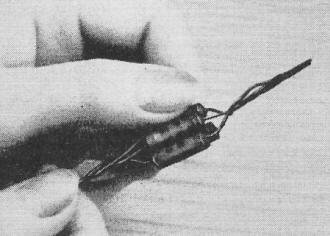
In disposing of these tubular ceramics, no effort was made to
even separate them from an adhesive strip. Obviously, they are all the same value.
We found that poly bag assortments included everything from floor sweepings of
some unknown manufacturer to carefully packaged, top-quality merchandise. The buyer
has no recourse (caveat emptor) but to accept what the poly bag contains without
question. The only firm guideline that we could uncover as to the possible worth
of a bargain bag is to know with whom you are dealing. Mail-order companies with
business reputations at stake and specialty houses dealing in bargain bags will
nine times out of ten sell exactly what they advertise. The same cannot be said
for at least one-third of surplus or distress equipment mail-order houses, or most
of the inhabitants of "radio row" stores in major metropolitan areas. The latter
stores - specializing in a walk-in-off-the-street trade - offer very tempting bargains
that are difficult to resist, But, resist them you should, even though the investment
is almost always under $2. Often as not, you'll be glad you did.
This was our prize purchase. All 481 resistors are of the same value although
the exterior wrapping of this assortment said it contained 100 different resistors.
In the politest terms, these four resistors can be called "floor sweepings."
Twisting the leads together was done by a technician, eliminating the chance that
the resistors would be new stock.
Bargains, Bargains, Bargains?

25 Mica Capacitors for 89¢
Although far from obsolete, this assortment clearly established
that mica capacitors are "on their way out." Capacitors from five different manufacturers
were represented and all showed distinct signs of aging. Seven capacitors had pre-World
War " color coding (nearly invisible) and two of the 27-μμf. capacitors were
unmarked. This was a local (New York City) purchase.
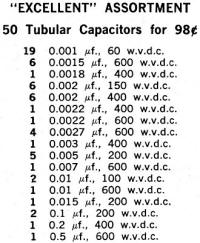
50 Tubular Capacitors for 98¢
This mail-order assortment contained 59 capacitors instead of
the advertised 50. All were in good shape, although obviously "over-runs" from TV
set manufacturers. All were clearly imprinted, and all tested "good."
As examples of "radio row" transactions, here are two instances that occurred
during our poly bag hunts in lower Manhattan. In one store a sign proclaimed drastic
price reductions in resistor assortments from $1.98 to $1.49 to a new final "low-low"
of 99¢ - an irresistible bargain. A sealed box (poly bag inside) was purchased and
from its weight appeared to be packed. It was - with 481 resistors of the same value!
A second store offered precision wire-wound and carbon-film resistors - 30 for $1.29.
The count was correct and we found values ranging from a low of 100 ohms to a high
of 3.32 megohms. However, four of the 30 resistors were unmarked and if you can
describe a more worthless electronic item than an unmarked "precision" resistor
we'd like to hear about it. Purchases via mail order from any of the five top distributors,
plus one specialty mail-order house, were satisfactory. With few exceptions, the
components were clean, well-marked, of fairly recent manufacture and of good quality.
A sampling of capacitors indicated that only one out of a possible 50 would be leaky,
shorted or open on being tested.
Some of the problems that do beset bargain capacitors, especially those purchased
from doubtful sources, are old, obsolete or indistinguishable color codes and markings.
Fortunately, these troubles do not usually affect resistors. Our sampling showed
that only one out of every 90 resistors would either be open or have indiscernible
markings.
"Bad" Assortment
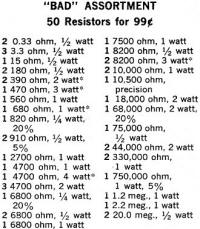
50 Resistors for 99¢
At first glance - while the resistors were still in the poly
bag-this looked like a promising purchase. Unfortunately, the assortment was more
of a hodge-podge containing all wattage values from 14 to 4 watts. Particularly
bad in this assortment was the absence of values in the range of 75,000 to 330,000
ohms. All resistors identified by the asterisk had no color code. This was a "radio
row" purchase.
"Excellent" Assortment
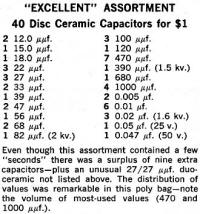
40 Disc Ceramic Capacitors for $1
Even though this assortment contained a few "seconds" there was
a surplus of nine extra capacitors - plus an unusual 27/27 μμf. duo-ceramic
not listed above. The distribution of values was remarkable in this poly bag - note
the volume of most-used values (470 and 1000 μμf.).
On the other hand, precision resistors are always a poor buy in poly bag assortments.
The offerings are generally over-production runs of highly irregular values used
in test equipment manufacture. Wattages are rarely indicated (perhaps on one unit
out of ten) and you take a chance. in using a precision resistor in any circuit
that draws more than a watt. Also, the need for precision resistors in everyday
electronic experimenting is unbelievably small.
What To Buy.
There are several rules-of-thumb in buying poly bags. If you can see the bags
be sure that component leads are uncut and have not been shortened for use in printed
circuit wiring. In the case of resistors, check that the one-half-watters have either
a silver or gold tolerance color-coding band. Also, ancient 2-watt resistors were
much longer and thinner than present-day units - they are not a good buy.
Capacitors must be watched carefully, although the signs of age are more obvious
(see photo) than with resistors. Ceramic disc capacitors should be checked for signs
of poor dipping - the colored ceramic insulation does not cover all of the capacitor
body. Units of this type are "seconds" and are not safe to use.
In the great welter of assortments, special "buys," and "good deals," the average
buyer of poly bags has reason . to be hopelessly confused when it comes to determining
just what he's getting for his money. In early December, as this article was written,
the following average prices (cents-per-unit) were computed from our survey.
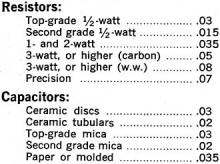
The experimenter will find that an $8-$10 investment in poly bag resistor and
capacitor assortments will be money well spent. We suggest that the following components
be purchased as a start: two good 1/2-watt resistor assortments, one good 1-watt
resistor assortment, one ceramic disc assortment, and two bags of mica or molded
capacitors. Unless you need them for some specific purpose, defer buying precision
resistors or electrolytic capacitors until a later date. However, if you expect
to tryout transistor circuits, a good assortment of high-capacitance, low-voltage
electrolytics can be added to the above list.
Posted February 12, 2020
|

















